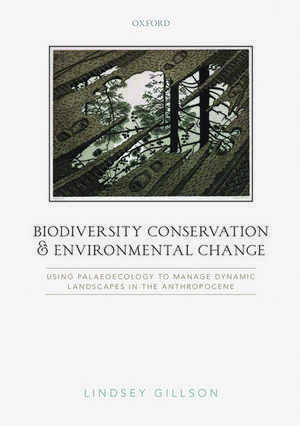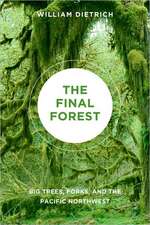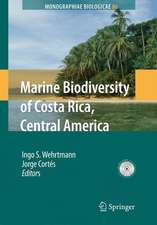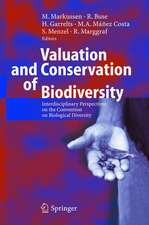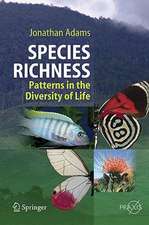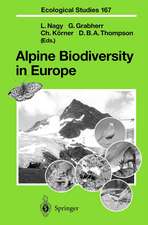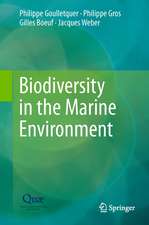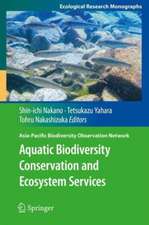Biodiversity Conservation and Environmental Change: Using palaeoecology to manage dynamic landscapes in the Anthropocene
Autor Lindsey Gillsonen Limba Engleză Hardback – 9 apr 2015
| Toate formatele și edițiile | Preț | Express |
|---|---|---|
| Paperback (1) | 370.32 lei 31-37 zile | |
| OUP OXFORD – 9 apr 2015 | 370.32 lei 31-37 zile | |
| Hardback (1) | 716.92 lei 31-37 zile | |
| OUP OXFORD – 9 apr 2015 | 716.92 lei 31-37 zile |
Preț: 716.92 lei
Preț vechi: 1085.58 lei
-34% Nou
Puncte Express: 1075
Preț estimativ în valută:
137.20€ • 142.42$ • 114.40£
137.20€ • 142.42$ • 114.40£
Carte tipărită la comandă
Livrare economică 11-17 martie
Preluare comenzi: 021 569.72.76
Specificații
ISBN-13: 9780198713036
ISBN-10: 0198713037
Pagini: 230
Dimensiuni: 171 x 239 x 18 mm
Greutate: 0.61 kg
Editura: OUP OXFORD
Colecția OUP Oxford
Locul publicării:Oxford, United Kingdom
ISBN-10: 0198713037
Pagini: 230
Dimensiuni: 171 x 239 x 18 mm
Greutate: 0.61 kg
Editura: OUP OXFORD
Colecția OUP Oxford
Locul publicării:Oxford, United Kingdom
Recenzii
This is an often thoughtful book which presents the value of palaeoecological research and data over timescales which embrace not just the Anthropocene, but long periods preceding it.
[T]his volume represents an important, and largely successful, attempt to highlight connections between paleoecology (and historical ecology) and applied ecology. At a time when scientists are increasingly specialists, Gillson's generalist approach should be commended.
[A] book like this that raises awareness and sets a strong case for making the effort is very necessary and should be widely welcomed.
The role of palaeoecology in improving understanding and shaping long term responses is stressed throughout. The case studies are varied in terms of both scale and location, ranging from African Savannas to New England...I have no hesitation in commending this valuable and scholarly book. It opens up new ground and makes connections that are long overdue and of real practical and theoretical significance.
an excellent text for a graduate or advanced undergraduate seminar in conservation biology, environmental policy, or, ideally, those linking the two
Gillson has provided a valuable, well-written, easy to understand book that demonstrates the practical and theoretical interconnectedness of past, present and future ecology.
[T]his volume represents an important, and largely successful, attempt to highlight connections between paleoecology (and historical ecology) and applied ecology. At a time when scientists are increasingly specialists, Gillson's generalist approach should be commended.
[A] book like this that raises awareness and sets a strong case for making the effort is very necessary and should be widely welcomed.
The role of palaeoecology in improving understanding and shaping long term responses is stressed throughout. The case studies are varied in terms of both scale and location, ranging from African Savannas to New England...I have no hesitation in commending this valuable and scholarly book. It opens up new ground and makes connections that are long overdue and of real practical and theoretical significance.
an excellent text for a graduate or advanced undergraduate seminar in conservation biology, environmental policy, or, ideally, those linking the two
Gillson has provided a valuable, well-written, easy to understand book that demonstrates the practical and theoretical interconnectedness of past, present and future ecology.
Notă biografică
Lindsey Gillson was educated at the University of Oxford and Imperial College London. She worked in wildlife conservation for several years before returning to Oxford to research the application of palaeoecology in conservation, specialising in the management of African savannas as the subject of her doctoral thesis. She was appointed Trapnell Fellow in African Terrestrial Ecology at the University of Oxford in 2001, and moved to South Africa in 2006 to take up a post at the University of Cape Town. She is Deputy Director of the Plant Conservation Unit, and continues to work on the application of long-term data in the conservation and management of African biomes, and in developing the interface between palaeoecology and conservation biology.
